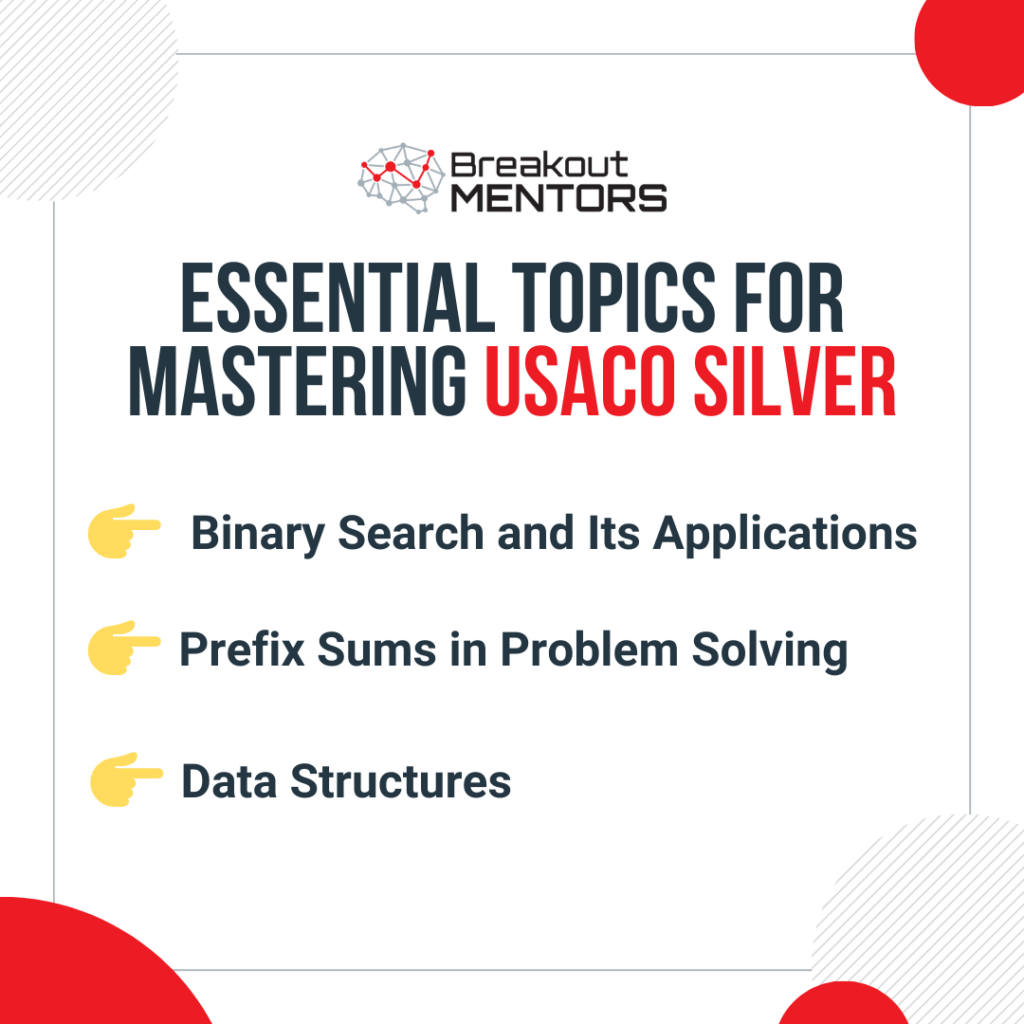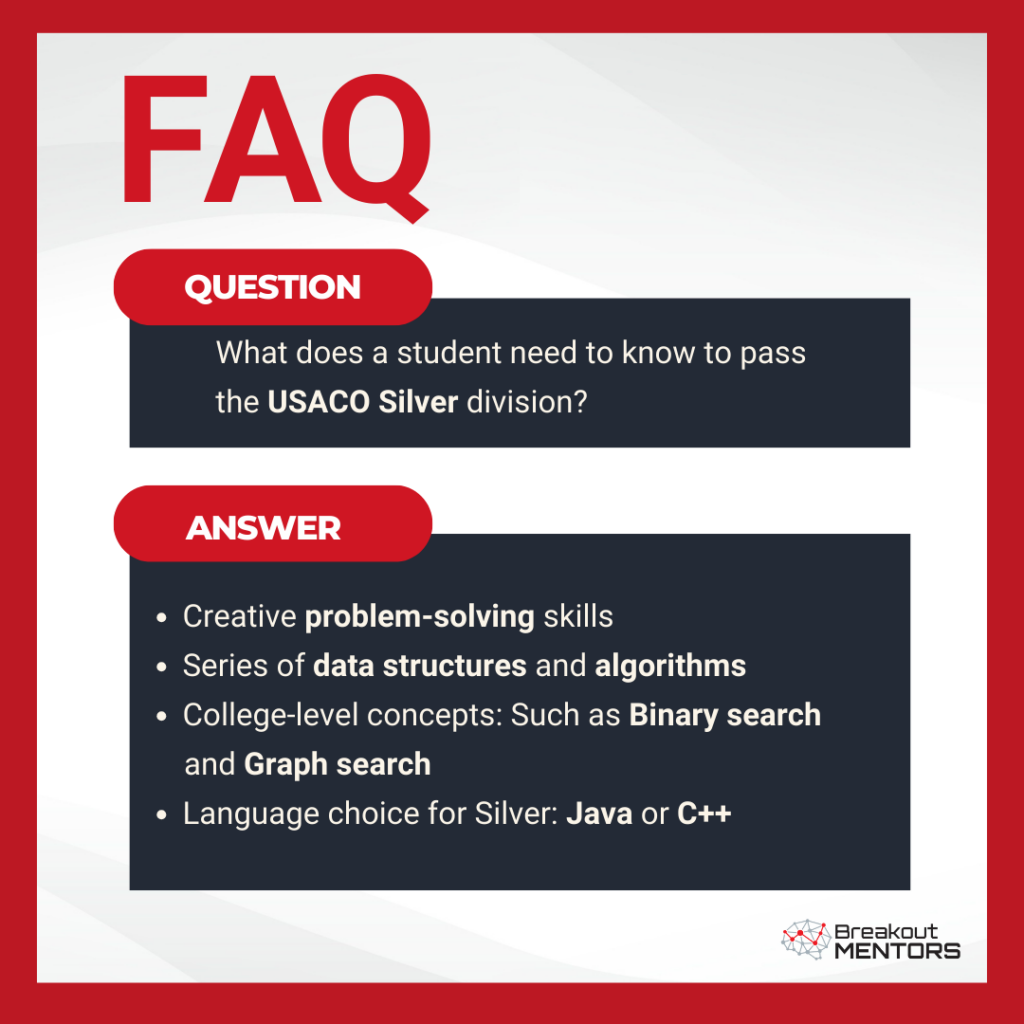Moving up to USACO Silver is a thrilling step in your competitive programming journey. It’s where you start to see the fruits of your labor in USACO Bronze. The skills we’ve honed, like problem solving insights, become even more critical. But the Silver division is also the point where advanced computer science concepts are necessary to solve the problems.
The quest to ace Silver will be challenging, but it is a rewarding journey, so I hope you are excited for what’s ahead.
The Journey from Bronze to Silver
In your journey from Bronze to Silver, you have already learned valuable problem-solving skills. This will be crucial for success to promote from Silver to Gold. You know that it isn’t linear straightforward thinking that is needed, but rather outside-the-box thinking.
Is Advancing to Silver Possible Without Clearing Bronze?
Interestingly, advancing to Silver without clearing Bronze is possible, thanks to in-contest promotions. Or put another way: you can do both Bronze and Silver in the same contest.
Here’s how in-contest promotions work. If you score a perfect 1000 points on Bronze, you’ll have the opportunity to take the Silver test on the same contest weekend. So take a break, get off the computer for a while, then take the Silver test when you are ready.
Silver: A Significant Leap in Difficulty
The leap to Silver is more than just a step up: it’s a significant jump in difficulty. The problems you’ll face require a deeper understanding and application of algorithms. It’s where you start to see the real beauty of problem solving unfold.
The Advantage for Bronze Perfect Scorers
If you achieved a perfect score in Bronze, you will have an edge. In order to get 1000 points on Bronze, you have already shown the ability to think critically about the runtime of your programs. This is a skill that becomes even more vital in Silver. Your ability to efficiently solve problems and optimize our solutions will be key to mastering the Silver division.
Essential Topics for Mastering USACO Silver

To excel in Silver, there is a list of computer science concepts you must learn. Understanding and mastering these data structures and algorithms will be crucial for tackling the complex problems you’ll face.
Mastering Binary Search and Its Applications
Binary search is a highly efficient algorithm used to find a target value within a sorted array or list. It works by recursively dividing in half the portion of the list that could contain the target, reducing the search area by half each time.
Here’s an analogy using a dictionary to explain binary search when looking up a word:
Imagine you have a dictionary and you want to look up the word “Programming.” The dictionary is sorted alphabetically, which is a key condition for binary search to work. Here’s how you’d proceed, akin to performing a binary search:
- Start in the Middle: You open the dictionary to the middle. Suppose you land on a page where the words start with “M.”
- Compare and Reduce the Search Area:
- If the middle word is “Programming,” you’re done.
- If “Programming” comes alphabetically before “M”, you eliminate the second half of the dictionary. If it comes after “M”, you’d eliminate the first half instead.
- Repeat the Process: Now, with the reduced section (M to Z), you open to the middle of this section. Let’s say you land on “U.” Since “Programming” comes before “U”, you eliminate all pages after. Your new search area is “M” to “U”.
I took you through a complete example of binary search to show how closely it is tied to runtime. You’ll see that throughout the other data structures and algorithms as well.
The Role of Prefix Sums in Problem Solving
Prefix sums are a game-changer in solving range queries efficiently. I like to call this: when is it efficient to store duplicate information?
Start with an array of numbers. A prefix sum is an array created to store the sums of all numbers to that index. This preprocessing step allows for efficient calculation of the sum of elements in any contiguous subarray within the original array. Utilizing prefix sums can greatly optimize algorithms that require frequent retrieval of sum queries, reducing time complexity from linear to constant time for each query.
Understanding Data Structures for Efficient Solutions
Efficient solutions in Silver often depend on the right choice of data structures. For Bronze, you almost exclusively use the array data structure. However, for Silver, you are going to need to learn a few other ways to store information.
Exploring Graphs, Trees, and Their Traversals
Graphs and trees are fundamental to many Silver problems. You will learn about different options for traversals and how to apply them in various scenarios.
For example, imagine a family tree drawn out. If you are looking for a certain person, should you start at the bottom and move up? This is called depth-first search. Or should you start at the top and move down? This is called breadth-first search.
Preparing Effectively for USACO Silver

As you approach studying for Silver, you’ll want to think about how to be as efficient as possible. It is vital to target problems and concepts that you are ready for: that stretch your comfort zone just enough, but not too much.
The process for studying for Silver isn’t drastically different than preparing for Bronze. However, there are more concepts to learn first. I call this the “book learning” phase. Only then can you properly tackle the more important problem solving insights.
What Programming Language Should You Use?
While Python was an excellent option in Bronze, it is no longer a great choice for Silver. Java is the logical next step, given its balance of readability and speed.
However, also be aware that C++ is the recommended choice in Gold for its efficiency and control. If you know you are going to compete in Gold, make a strategic choice about the programming languages to best support your advancement.
Initial Learning of the Concepts
To be successful in Silver, understanding the core concepts is your first step. It doesn’t matter too much where you learn this: a book, a course, or a free online resource like USACO Guide. That will take you through some straightforward examples of how to use the algorithm and data structure. You should write your own code to get used to the process.
Training for Problem Solving Insights
Once we grasp the concepts, the difficult part is how to improve your problem-solving skills. This involves tackling a wide range of problems to understand different scenarios and how to approach them. We analyze problems, break them down, and apply concepts we’ve learned. This stage is about connecting dots and seeing the bigger picture, which is essential for navigating the complexities of competitive programming effectively.
Strategies for Dealing with Difficult Problems
Encountering tough problems can be intimidating and happens frequently at the Silver level. It is all a part of the learning process.
We encourage our students to think away from the computer. Read the problem statement, then take some deep breaths and pace around. Don’t be in a hurry to jump into coding until your approach is solidified.
It’s also helpful to revisit similar problems you’ve solved before, as they can provide insights. What problems are similar?
How Much Practice is Truly Necessary?
Practice is the backbone of success in competitive programming. But how much is enough?
It is important to realize that time spent isn’t the optimal variable to tweak. We believe in quality over quantity. First, make sure you are working on problems that stretch your comfort zone and not just looking at solutions when you are stuck. Set aside consistent time each week to keep making learning progress.
Silver Contest Strategy and Partial Points
As you likely observed in the USACO Bronze division, each contest includes a range of problem difficulty. The first two problems are more straightforward, with the third problem requiring some tough insights necessary to earn full points.
In Silver it is important to realize that you don’t need a perfect 1000 points in order to advance divisions. If you get 13 out of 15 test cases on problem 1, it might not be wise to spend 20 minutes attempting to get those final points. If you find yourself trying a drastically different approach, instead remember it for if you have time at the end.
Unlocking Your Potential in Competitive Programming

The transitioning from USACO Bronze to Silver is a significant leap that requires not just hard work but also smart strategies. In fact, it is the largest gap between divisions. Chances are if you can pass Silver, then you’ll have the skills to do well in USACO Gold.
One effective approach is training one-on-one with someone who has already mastered the competition. This method allows you to learn from their experiences, understand the nuances of ad hoc problems, and get personalized feedback on your solutions. It’s like having a guide who has already navigated the path you are on.
Moreover, they can help you focus on the right problems to practice. They can notice if you have a weakness with a certain concept and help fill in the gaps with targeted practice. They can also help you draw parallels between other problems you have seen.
Are you ready to discuss your specifics and if you would be a fit for 1-on-1 mentoring? Please fill this out and our USACO experts will reach out for a phone call.
Additional Resources: Check our our related articles
- USACO Training: Developing Young Minds in Computer Science
- Mastering USACO Bronze: Everything You Must Know to Ace the Contest
- Mastering the USACO Gold Division: A Comprehensive Guide
